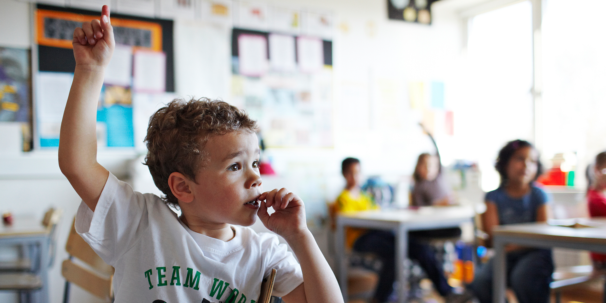What is social-emotional learning and how can you implement it?
Discover the meaning and importance of social-emotional learning and find out how you can implement it within your classroom.

Awareness of social-emotional learning is increasing, with more teachers and education providers implementing methods to increase social-emotional learning efforts. This type of learning develops key skills to provide children with a successful and fulfilling learning and life experience.
In this article, we will discuss what social-emotional learning means, its importance, and how you can implement it in your classroom. We will also discuss skills that social-emotional learning develops and some social-emotional learning activities.
What is social-emotional learning?
Before we begin, let’s unravel the social-emotional learning term. We can define social-emotional learning as the process of learning and developing both social and emotional skills.
When we say social skills, we mean those of verbal and non-verbal communication or interaction skills. On the other hand, emotional skills are the ability to understand and regulate thoughts, emotions and behaviours. Due to these two areas being so closely interlinked, the term ‘social-emotional’ has been coined.
Whether you have heard of this term before or it’s a brand new concept to you, it’s important to understand the impact and importance of social-emotional learning. It is just as important as standard curriculum topics such as mathematics or English, as it provides children with skills that will support them throughout their school, work and home lives.
The principles of social-emotional learning
So, what makes learning social and emotional? Social-emotional learning, or SEL for short, differs in nature from standard curriculum topics. Despite being just as crucial, there is not as much awareness or exposure of SEL education. Let’s look at the principles of social-emotional learning and social-emotional teaching:
- Create – you should aim to create a nurturing, safe and caring environment for all students. To learn more about how to create an inclusive classroom environment, check out our Education for all: disability, diversity and inclusion course.
- Integrate – social-emotional learning should be integrated into standard lessons where possible. You can implement SEL through effective lesson planning.
- Communicate – distribute social-emotional learning information amongst coworkers and other stakeholders. Concerns and progress should be shared with parents and other school staff.
- Instruct – just as you would with other curriculum topics, SEL should be taught to students via guidance and instruction.
- Empower – ultimately, social-emotional learning should aim to empower students and equip them with the skills to take control of their own social and emotional abilities with confidence.
To learn more about how to support students with SEL, check out our Supporting adolescents: social and emotional wellbeing course.
CASEL framework
The Collaborative for Academic, Social and Emotional Learning, or CASEL for short, have created a framework to follow for optimal SEL implementation. CASEL’s framework identifies five key areas of competencies that should be met to come together and create a strong sense of self for students:
- Self-awareness – this includes understanding our thoughts and feelings, what we are and what we can become.
- Social awareness – the CASEL framework isn’t just about individual development – it aims to create a healthy school-wide culture and group environment. Thus, the social awareness section is all about understanding others and being able to empathise with all kinds of people.
- Self-management – closely linked with self-awareness, this segment of the framework is the ability to control our thoughts and feelings, as well as our emotions.
- Relationship skills – building on the social awareness area of the framework, this section encourages effective communication and connecting with others.
- Responsible decision making – based on all other sections of the framework that we’ve mentioned, this final section entails using those skills to make informed and effective decisions.
As well as these key competencies, CASEL also outlines key settings that can influence a student’s social-emotional learning. These key settings are communities, families or caregivers, schools and classrooms. It’s worth noting that CASEL is a US-based incentive. If you are UK-based, the Social and emotional aspects of learning (SEAL) programme applies similar values.


Why is social-emotional learning important?
It’s not difficult to imagine how these skills can benefit children in school and in their everyday lives. Social-emotional skills allow children to understand their peers, control their emotions, and seek out the help they need from their teachers and parental figures.
What skills does SEL develop?
SEL education creates an environment where students can build and develop crucial life skills and prepare them for the future. Let’s look at some of the key skills social-emotional learning develops.
Emotion management
Children often act on their emotions without fully understanding what they are feeling. Social-emotional teaching can nurture emotion management skills, leading to a deeper understanding of why thoughts and feelings are processed the way they are.
This can also greatly improve student behaviour as it gives them a chance to stop and think about why they may act in a negative manner. For a deeper understanding of behaviour management for students, check out our managing behaviour for learning course.
This area is particularly important for those who may struggle more than others with understanding emotions due to learning disabilities, like autism or other factors such as previous trauma.
Decision making
SEL education helps students utilise their knowledge of emotions and empathy to make effective decisions. Rather than acting impulsively, students will be equipped with the skills to think situations through and decide which route to take. This ability, whilst cultivated at a young age, can massively improve the lives of students when they reach adult years.
Empathy
This crucial skill equips students with the ability to relate, accept and connect with others regardless of their differences. Uniqueness should be celebrated, and empathy encourages this behaviour rather than allowing students to shy away from any differences amongst their peers. By sharing stories amongst each other and listening to their peers, students will begin to empathise with one another.
Understand and develop relationships
Closely interlinked with empathy, the ability to understand and develop relationships with others is crucial for student development. Maintaining meaningful relationships is a key component to a positive learning experience, and entails communication, negotiation and resisting negative social pressure.
Students can learn to develop relationships with not only their peers, but also with teachers. Our Communicating effectively with vulnerable children and young people course is great if you’d like to learn more about how to communicate with your students.
Successful school development
Personal development isn’t the only benefit of SEL; it has a significant impact on the wider school community. SEL gives teachers a way to solve conflicts between students that results in a positive outcome.
This skill, combined with the students’ increased knowledge of responding to emotions and empathising with others, makes for a strongly connected school community. With happier, more involved students, academic outcomes are also increased. All of this adds to the success of each school.
As well as adding to the school community, SEL can also have positive financial impacts on schools. Multiple studies have shown that social-emotional learning has a positive return on investment, with every dollar spent on SEL advancements returning ten dollars back to the school.
Academic benefits
Social-emotional learning is well researched, and there is an array of evidence to show that SEL education is an effective tool. Amongst this research is evidence that SEL has clear academic benefits. There are reports of higher graduation rates, reduced expulsion rates, lower suspension numbers and higher attendance rates.
Evidence also shows that academic results increased in terms of percentile points after SEL implementation, and classroom behaviour improved. Beyond academic results, there is also research to suggest that social-emotional learning carries on making a difference in adulthood too – with students less likely to be involved in police altercations.
Social-emotional learning and COVID-19
Social-emotional learning is more important than ever before – students are learning to navigate a new normal, and this can lead to a range of emotions. Whether it’s a shift to learning online, wearing masks in the playground or social distancing amongst classmates, students have had their world turned upside down in recent years.
Such intense changes to a student’s routine can lead to stress, fear, anger, depression or anxiety. SEL is critical right now to give students the skills to understand what’s happening and help them process these changes correctly. We can support students throughout these difficult times by embedding mental health in the curriculum within our schools.
If you’re interested in learning more about navigating these potential mental health issues, check out our young people and their mental health course.
One of the main skills that social-emotional learning develops is the ability to build and maintain relationships. This goes hand-in-hand with student support after the pandemic; there is a lot of uncertainty for students right now, and they have likely spent a lot of time away from their peers. Social-emotional skills can help rebuild meaningful relationships amongst students and with teachers, even if it’s via teaching online.
Who can benefit from SEL?
Emotions are a part of who we are from a very early age. Multiple studies have shown that children from as young as 6 months old can differentiate between different emotions. From early on, we gather and interpret the wealth of available information and experiences surrounding us, whether it be through smell, touch, taste, sound or sight.
Children can showcase their own emotions at a young age; take a baby crying for their mother’s attention, for example. However, the ability to understand and navigate these emotions does not come naturally.
That’s where SEL comes in. Social-emotional learning is most effective when implemented early on in a child’s life and continues throughout primary school and secondary school. Thus, social-emotional teaching should be a constant throughout the formative years of any child, regardless of age.
Social-emotional learning also provides support to teachers, teaching assistants and other members of the school community. By helping educators manage their stress levels and connect with their students, the wider school community can be strengthened.
Challenges of SEL
The benefits of social-emotional learning are clear, but as with everything, some challenges are presented via SEL. Here are a few things to be aware of when implementing your social-emotional teaching plan:
- Measuring success – SEL cannot be assessed or graded in the way that typical school subjects can. Care needs to be taken to make sure that students receive the right support and receive effective social-emotional learning, even if it cannot be assessed using traditional methods.
- Resources – there is not a huge wealth of information and resources available in terms of implementing social-emotional learning. It is still a relatively new topic, and so there are not years worth of content and experience like there are in other areas. However, there is extensive research to show how effective social-emotional learning can be, so it’s still important to implement. You can find creative ways to implement it within the classroom and see what works for your school.
- Training – for all educators to effectively implement SEL in the classrooms, there needs to be a strong training arrangement in place. This applies to both in-person classrooms and remote classrooms. In a recent survey, 84% of teachers said that all online teachers should receive specialised training to support students’ social-emotional learning.






How can you implement social-emotional learning in the classroom?
If you’re an educator or have plans of becoming a teacher, you may be wondering how you can implement the magic that is social-emotional learning in your own classroom. We all want the best for our students and to improve their quality of life as well as their learning potential. Let’s dive into some of the ways we can implement social-emotional learning in the classroom.
Define and verbalise emotions
Acknowledging that emotions are there is the first step towards successful SEL. It’s important that students begin to understand what emotions are to then understand why they feel certain emotions. You can do this by talking through emotions or through written exercises.
By acknowledging and understanding emotions, children can explain their feelings better to educators and parents and work through them together. As we briefly mentioned earlier, emotion management also reduces the risk of bad behaviours since students can regulate their feelings rather than act impulsively.
Social-emotional learning through play
One of the best ways to incorporate social-emotional learning in the classroom is through play. Students learn to engage with one another and build an understanding of sharing via play. Opportunities to increase confidence and negotiate also arise, all while providing a fun and engaging experience.
For an in depth understanding of social-emotional learning through play, check out our Coping with changes: social-emotional learning through play course.
Learning through stories
Everybody loves a good story, and storytelling is one of the best ways to get messages across to young minds. Characters in books showcasing their emotions, thoughts, feelings and critical thinking are a great way for students to relate to these processes via immersion. Depending on the age group and skill level of your students, you could have a collective story time or assign students their own respective books.
Social-emotional learning activities
Group problem solving
Group work is a great way to encourage healthy relationship building, whether it’s with a puzzle or a mystery-solving scenario for students. Problem-solving allows students to work with one another and tackle a task together, while encouraging critical thinking to figure out their collective task.
Discuss diversity
Empathy and understanding of others is a major part of social-emotional learning. We need to encourage students to accept one another and connect with all of their peers, regardless of culture, gender, ability or background.
By opening classroom discussions about students’ diverse backgrounds, students can appreciate the differences between their classmates, celebrate uniqueness and develop the ability to communicate with diverse audiences. A fun approach to this could be a show and tell day where students each bring in an item from their own cultural background.
Creative writing
Not only does this activity boost students’ writing skills, but it is also an incredible SEL tool. By giving students the ability to world-build and make up their own characters, they can express emotions through their writing. This outlet is a great way for students to start understanding how emotions work and how to act on them.
Reflection
It’s easy to end a school day without looking back on how the day panned out and what went well or maybe didn’t go so well. Central to the social-emotional learning principles is the ability to understand and think about our emotions.
By offering a chance at the end of the day for students to share what they learned, what their wins were or what they struggled with, we are giving them a voice to share how they feel.
Discussing emotions is a major step in understanding and acting on them effectively. This also encourages mindfulness and can enhance a healthy classwide relationship if shared out loud. Alternatively, we could present this task in the form of a journal and let students get their thoughts out onto paper.




Final thoughts
Social-emotional learning is a critical component to any developing child’s world, and the sooner it is implemented, the better. We hope that this article has offered a strong understanding of what social-emotional learning is and its importance.
Hopefully, you now feel ready to implement social-emotional teaching yourself if you have the means to do so. If you’re interested in learning more about building social skills for children, check out our Social learning and collaboration in school course.





